Applied Study of the Fluidization Model of Logistics Transportation through the Prism of the Impact Generated on the Environment
Abstract
:1. Introduction
2. Discussion Regarding Urban Transport Characteristics and the Evolution of Urban Densities
2.1. Presentation of Approaches Regarding Transport Policies and Imposed Limitations
2.2. Studies and Analyzes Regarding the Restriction of Freight Transport and Methods
3. Presentation and Investigation of the Transport Structure Analysis Model
3.1. Discussion Regarding the Route Optimization Model for Oversize Vehicles Taking into Account the Impact of Environmental Pollution
Analysis of the Costs Generated by Traffic Congestion, Referring also to the Cost of CO2 Emissions
4. Implementation of the Simulation Model and Analysis of the Urban Area
4.1. Simulative Implementation of the Case Study in Relation to the Analyzed Urban Area
4.2. The Implementation of the Simulation Model and the Presentation of the Architecture Created in order to Obtain a Logistic Flow for the Transport of Large Tonnage
5. Conclusions
Author Contributions
Funding
Institutional Review Board Statement
Informed Consent Statement
Acknowledgments
Conflicts of Interest
References
- Zadobrischi, E. Intelligent traffic monitoring through heterogeneous and autonomous networks dedicated to traffic automation. Sensors 2022, 22, 7861. [Google Scholar] [CrossRef]
- Zadobrischi, E.; Dimian, M. Inter-urban analysis of pedestrian and drivers through a vehicular network based on hybrid communications embedded in a portable car system and advanced image processing technologies. Remote Sens. 2021, 13, 1234. [Google Scholar] [CrossRef]
- Arvidsson, N. Thee milk run revisited: A load factor paradox with economic and environmental implications for urban freight transport. Transp. Res. Part A Policy Pract. 2013, 51, 56–62. [Google Scholar] [CrossRef] [Green Version]
- Russo, F.; Comi, A. City characteristics and urban goods movements: A way to environmental transportation system in a sustainable city. Procedia-Soc. Behav. Sci. 2012, 39, 61–73. [Google Scholar] [CrossRef]
- Teo, J.S.E.; Taniguchi, E.; Qureshi, A.G. Evaluation of load factor control and urban freight road pricing joint schemes with multi-agent systems learning models. Procedia Soc. Behav. Sci. 2014, 125, 62–74. [Google Scholar] [CrossRef] [Green Version]
- Yong, Y.; Jing, W. Study of logistics network optimization model considering carbon emissions. Int. J. Syst. Assur. Eng. Manag. 2013, 8, 1102–1108. [Google Scholar]
- Minken, H.; Johansen, B.G. A logistics cost function with explicit transport costs. Econ. Transp. 2019, 19, 100116. [Google Scholar] [CrossRef]
- Tavasszy, L.A. Predicting the effects of logistics innovations on freight systems: Directions for research. Transp. Policy 2020, 86, A1–A6. [Google Scholar] [CrossRef]
- Kadłubek, M.; Thalassinos, E.; Domagała, J.; Grabowska, S.; Saniuk, S. Intelligent transportation system applications and logistics resources for logistics customer service in road freight transport enterprises. Energies 2022, 15, 4668. [Google Scholar] [CrossRef]
- Szarata, A.; Nosal, K.; Duda-Wiertel, U.; Franek, L. The impact of the car restrictions implemented in the city centre on the public space quality. Transp. Res. Procedia 2017, 27, 752–759. [Google Scholar] [CrossRef]
- Mcleod, F.; Cherrett, T.; Song, L. Transport impacts of local collection/delivery points. Int. J. Logist. Res. Appl. 2006, 9, 307–317. [Google Scholar] [CrossRef]
- Boysen, N.; Fedtke, S.; Schwerdfeger, S. Last-mile delivery concepts: A survey from an operational research perspective. OR Spectr. 2021, 43, 1–58. [Google Scholar] [CrossRef]
- Sharmilaa, G.; Ilango, T. Vehicular air pollution based on traffic density—A case study. Mater. Today Proc. 2022, 52, 532–536. [Google Scholar] [CrossRef]
- Nagy, S.G.; Šiljak, D. Is the European Union still a convergence machine? Acta Oeconomica 2022, 72, 47–63. Available online: https://akjournals.com/view/journals/032/72/1/article-p47.xml (accessed on 2 November 2022). [CrossRef]
- Grange, L.D.; Troncoso, R. Impacts of vehicle restrictions on urban transport flows: The case of Santiago, Chile. Transp. Policy 2011, 18, 862–869. [Google Scholar] [CrossRef]
- Heike, F.; Wolff, J. Impacts of planning and policy strategies on freight flows in urban areas. Transp. Res. Procedia 2016, 12, 584–597. [Google Scholar]
- Chin, S.-M.; Hwang, H.-L.; Lim, H.; Wang, C. Estimating truck load factors using truck volume and weight data. In Proceedings of the National Travel Monitoring Exposition and Conference (NaTMEC), Virtual Conference, 13–17 June 2022. [Google Scholar] [CrossRef]
- Nocera, S.; Basso, M.; Cavallaro, F. Micro and Macro modelling approaches for the evaluation of the carbon impacts of transportation. Transp. Res. Procedia 2017, 24, 146–154. [Google Scholar] [CrossRef]
- Lyu, P.; Wang, P.; Liu, Y.; Wang, Y. Review of the studies on emission evaluation approaches for operating vehicles. J. Traffic Transp. Eng. 2021, 8, 493–509. [Google Scholar] [CrossRef]
- Dijkstra, E.W. A note on two problems in connexion with graphs. Numerische Mathematik 1959, 1, 269–271. [Google Scholar] [CrossRef] [Green Version]
- Floyd, R.W. Algorithm 97: Shortest path. Commun. ACM 1962, 5, 345. [Google Scholar] [CrossRef]
- Dantzig, G.B.; Ramser, J.H. The truck dispatching problem. Manag. Sci. 1959, 6, 80–91. [Google Scholar] [CrossRef]
- Bolufé-Röhler, A.; Pereira, J.; Fiol-González, S. Traffic flow estimation using ant colony optimization algorithms. Comput. Sist. 2014, 18, 37–50. [Google Scholar] [CrossRef]
- Isa, N. Traffic routing optimization using ant colony optimization. Int. J. Adv. Trends Comput. Sci. Eng. 2019, 8, 81–86. [Google Scholar] [CrossRef]
- Yan, R.; Wang, S.; Zhen, L.; Laporte, G. Emerging approaches applied to maritime transport research: Past and future. Commun. Transp. Res. 2021, 1, 100011. [Google Scholar] [CrossRef]
- Kaddoura, I.; Kickhöfer, B.; Neumann, A.; Tirachini, A. Optimal public transport pricing: Towards an agent-based marginal social cost approach. J. Transp. Econ. Policy 2015, 49, 200–218. [Google Scholar]
- Godavarthy, R.; Russell, E.; Landman, D. Using vehicle simulations to understand strategies for accommodating oversize, overweight vehicles at roundabouts. Transp. Res. Part A Policy Pract. 2016, 87, 41–50. [Google Scholar] [CrossRef]
- Cosgrove, S.B.; William, L.H. The external congestion costs of differential vehicle sizes. J. Transp. Econ. Policy 2012, 46, 67–78. Available online: https://www.jstor.org/stable/23072187 (accessed on 2 November 2022).
- Bryce, J.; Santos, J.; Flintsch, G.; Katicha, S.; Mcghee, K.; Ferreira, A. Analysis of rolling resistance models to analyse vehicle fuel consumption as a function of pavement properties. Asphalt Pavements. In Proceedings of the International Conference on Asphalt Pavements, ISAP 2014, Releigh, NC, USA, 1–5 June 2014; p. 1, ISBN 9780429226779. [Google Scholar]
- Zadobrischi, E.; Cosovanu, L.-M.; Dimian, M. Traffic flow density model and dynamic traffic congestion model simulation based on practice case with vehicle network and system traffic intelligent communication. Symmetry 2020, 12, 1172. [Google Scholar] [CrossRef]
- Lozhkin, V.; Lozhkina, O.; Dobromirov, V. A study of air pollution by exhaust gases from cars in well courtyards of Saint Petersburg. Transp. Res. Procedia 2018, 36, 453–458. [Google Scholar] [CrossRef]
- Wang, Y.; Peng, Z.; Wang, K.; Song, X.; Yao, B.; Feng, T. Research on urban road congestion pricing strategy considering carbon dioxide emissions. Sustainability 2015, 7, 10534–10553. [Google Scholar] [CrossRef] [Green Version]
- Renfrew, D.; Yu, X.-H. Traffic signal optimization using Ant Colony Algorithm. In Proceedings of the 2012 International Joint Conference on Neural Networks (IJCNN), Brisbane, Australia, 10–15 June 2012; pp. 1–7. [Google Scholar] [CrossRef] [Green Version]
- Wang, J.; Chi, L.; Hu, X.; Zhou, H. Urban traffic congestion pricing model with the consideration of carbon emissions cost. Sustainability 2014, 6, 676–691. [Google Scholar] [CrossRef] [Green Version]
- Gonzalez-Pardo, A.; Del Ser, J.; Camacho, D. Comparative study of pheromone control heuristics in ACO algorithms for solving RCPSP problems. Appl. Soft Comput. 2017, 60, 241–255. [Google Scholar] [CrossRef]
- Alves, D.; van Ast, J.; Cong, Z.; de Schutter, B.; Babuska, R. Ant colony optimization for traffic dispersion routing. In Proceedings of the 13th International IEEE Conference on Intelligent Transportation Systems (ITSC 2010), Madeira Island, Portugal, 19–20 September 2010; pp. 683–688. [Google Scholar]
- Kasture, P.; Nishimura, H. Congestion-free ant traffic: Jam absorption mechanism in multiple platoons. Appl. Sci. 2019, 9, 2918. [Google Scholar] [CrossRef] [Green Version]
- Căilean, A.-M.; Beguni, C.; Avătămăniței, S.-A.; Dimian, M.; Popa, V. Design, Implementation and experimental investigation of a pedestrian street crossing assistance system based on visible light communications. Sensors 2022, 22, 5481. [Google Scholar] [CrossRef] [PubMed]

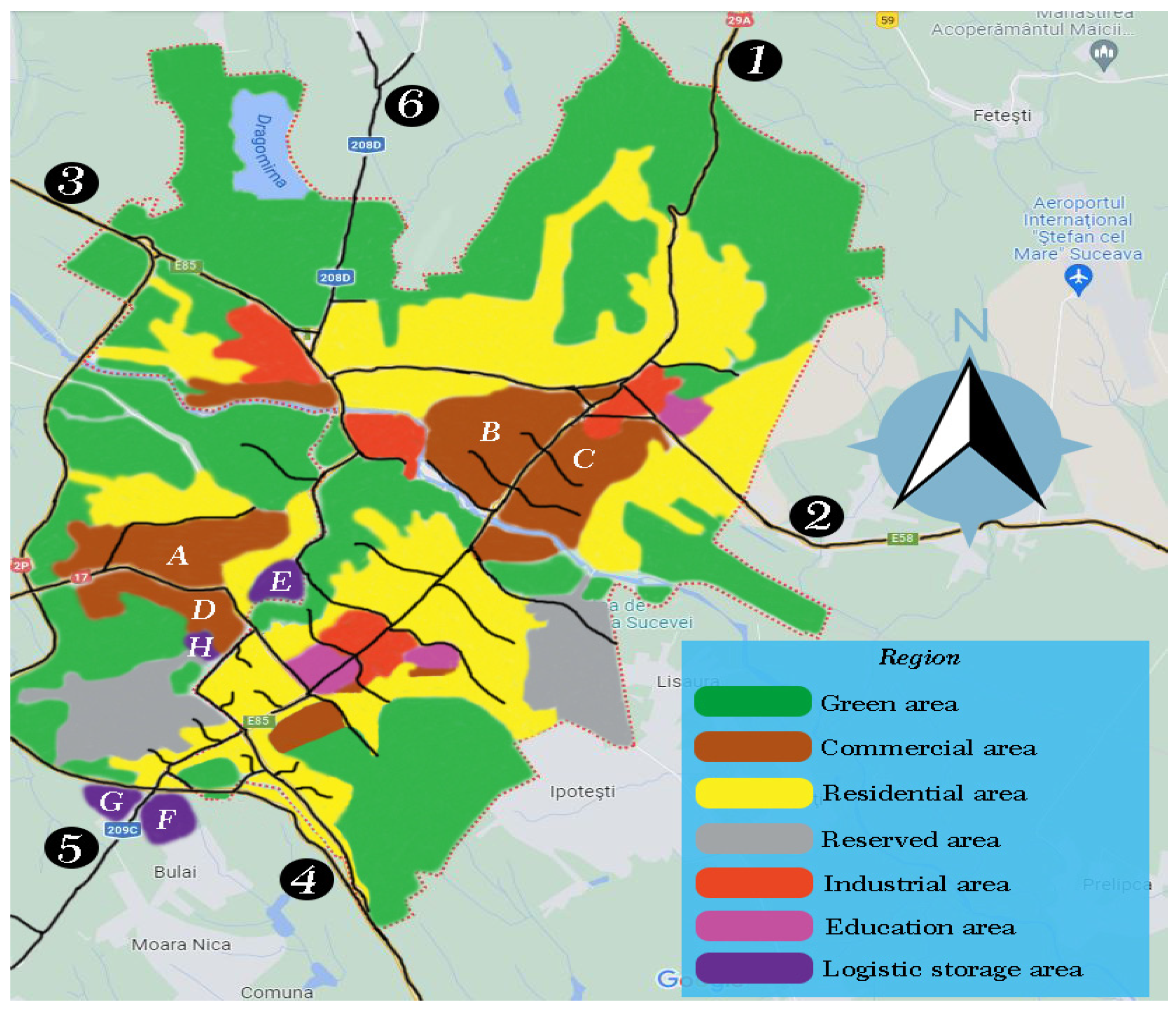
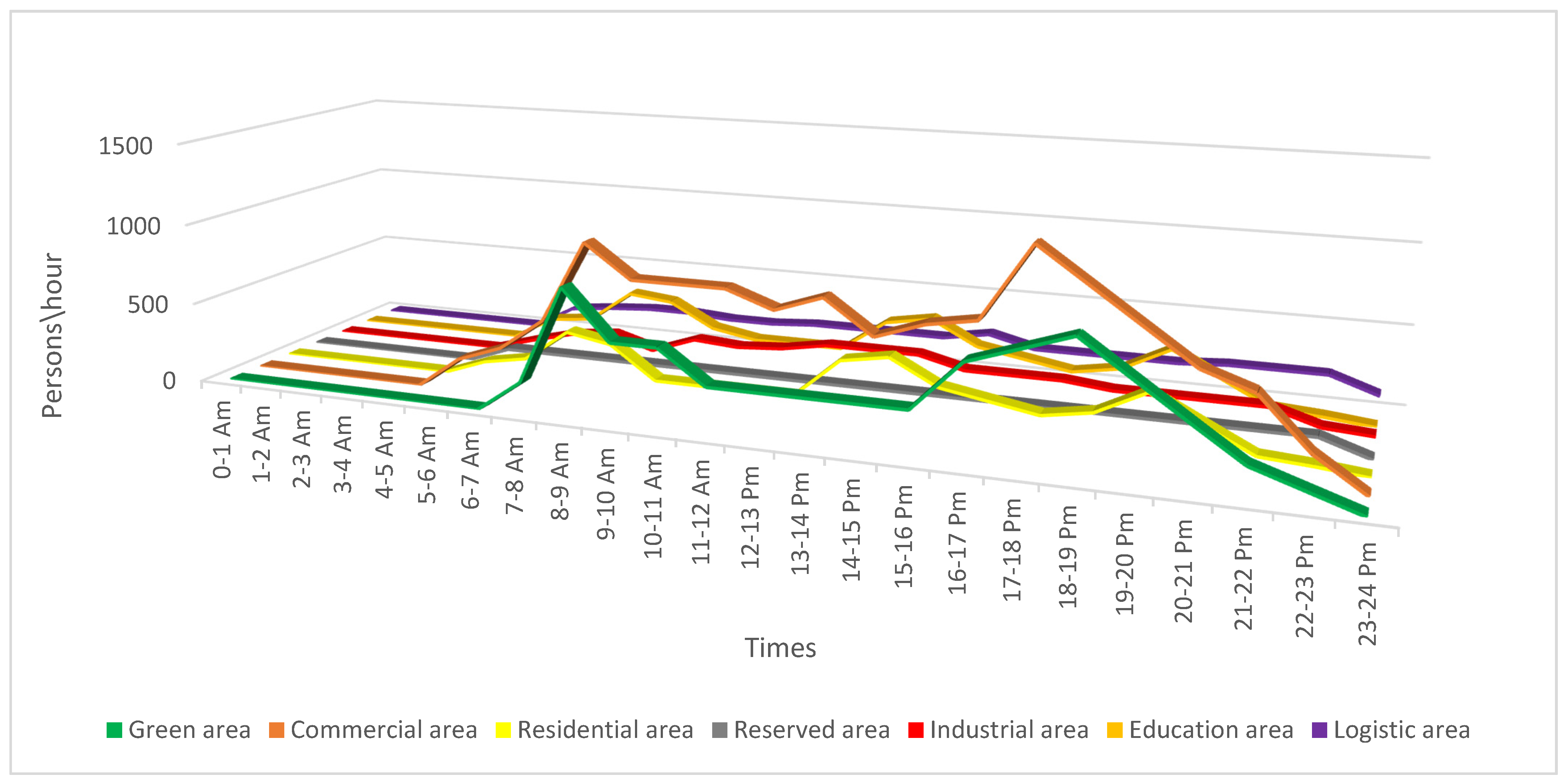
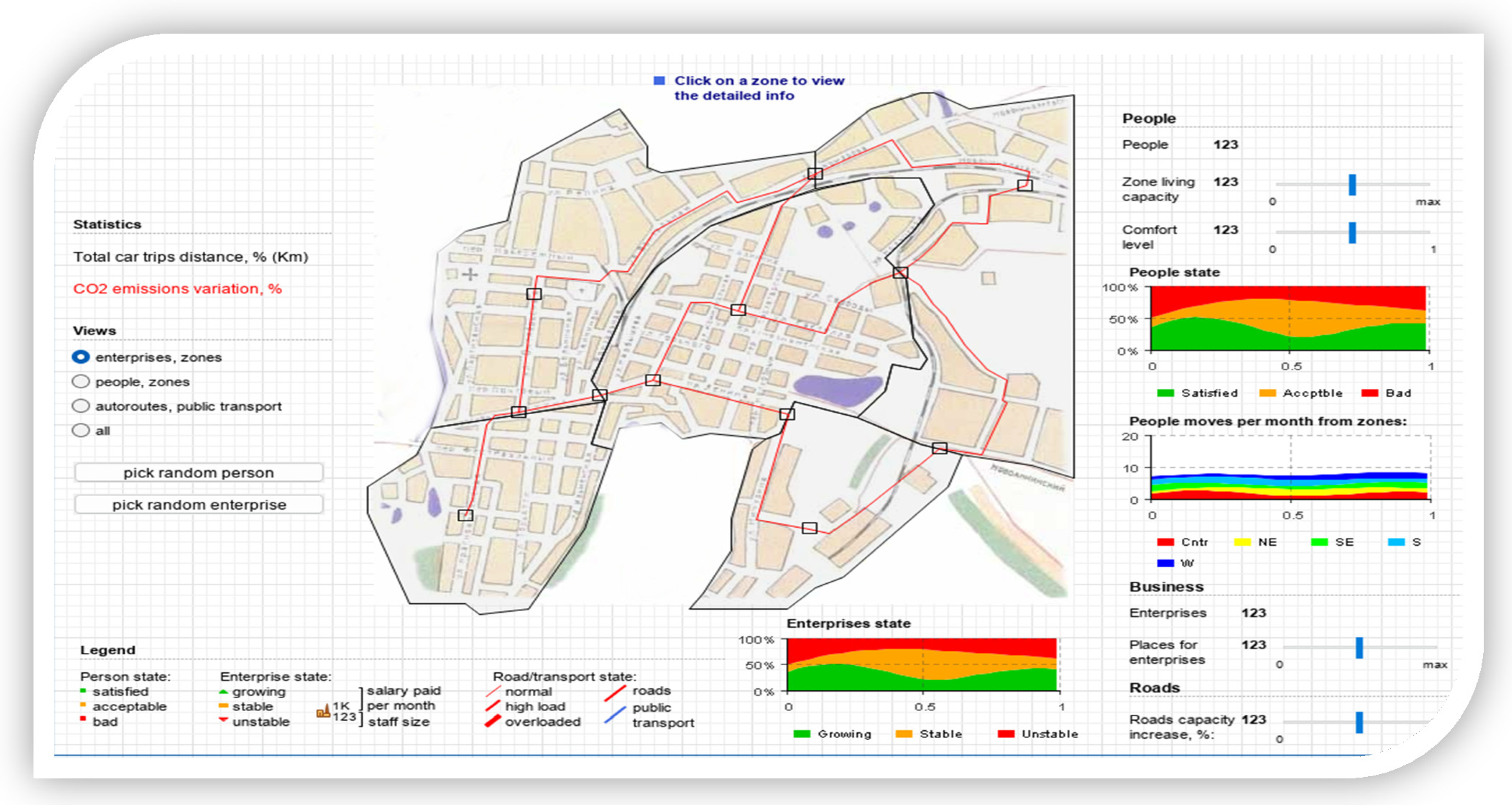

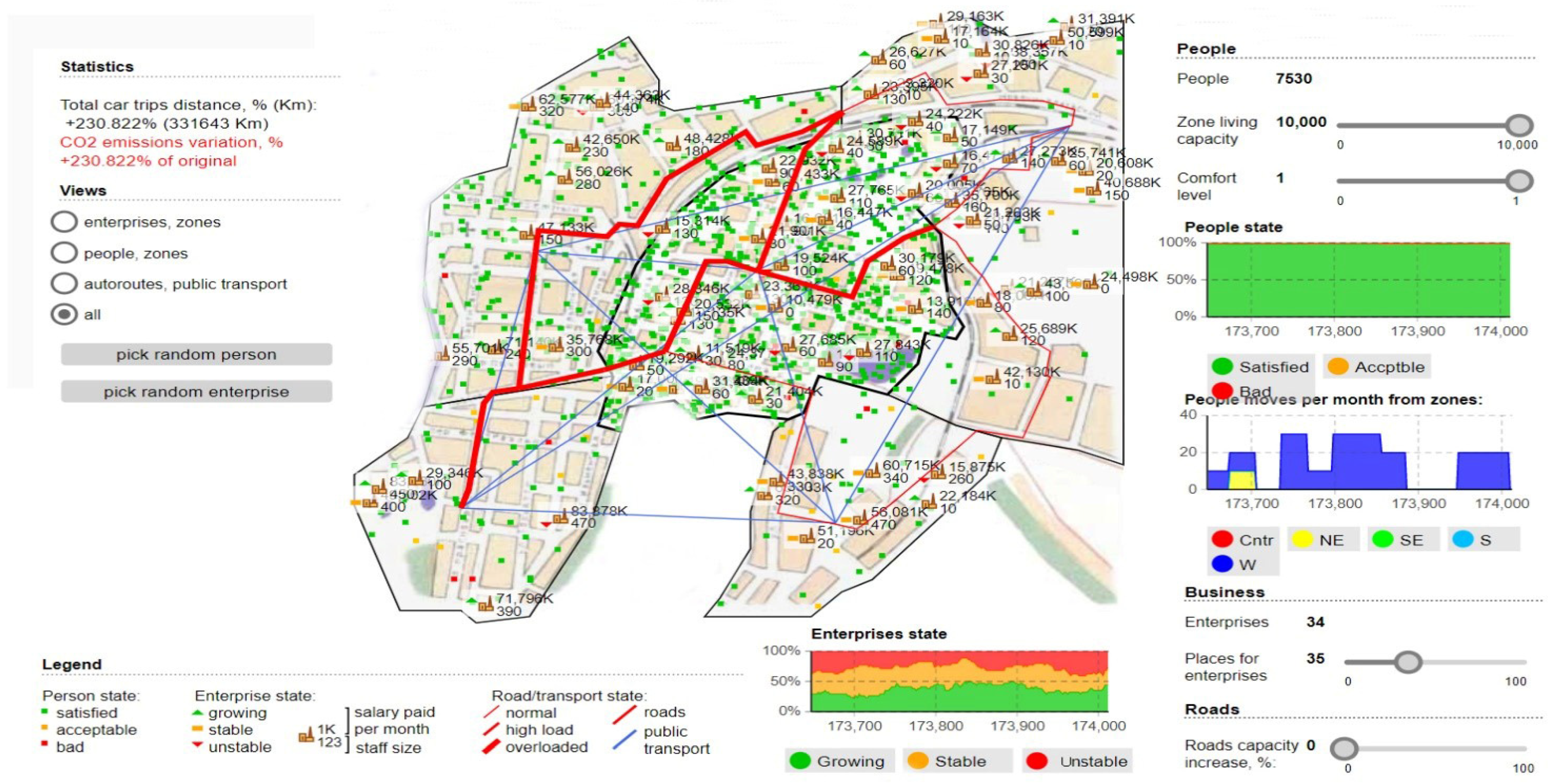
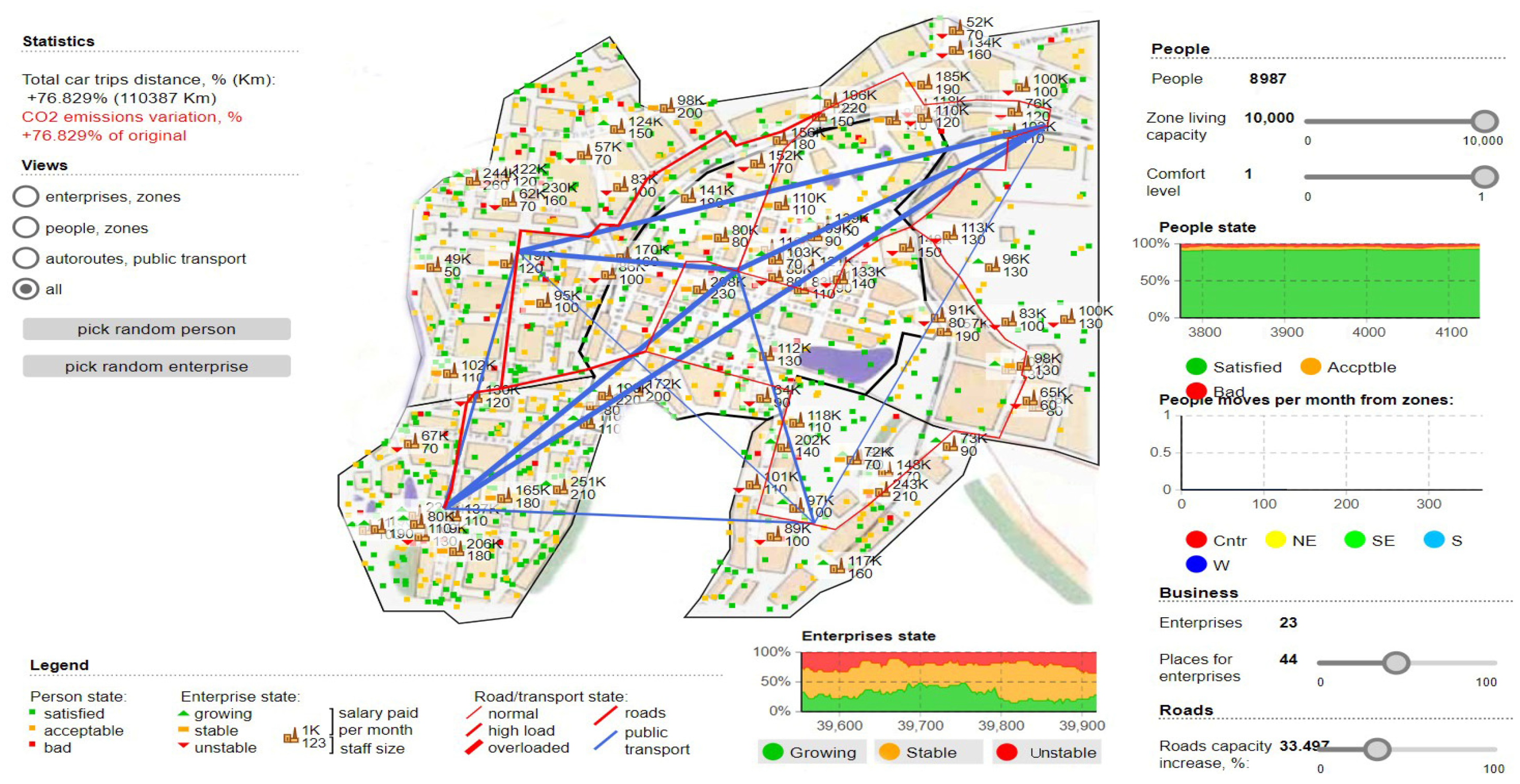
| Speed Vehicles | Emissions | Heavy-Duty Gasoline Vehicles | Light-Duty Diesel Vehicles | Medium-Duty Diesel Trucks | Very Large-Duty Vehicles |
|---|---|---|---|---|---|
| 5 | CO NOx | 68.12 2.56 | 27.44 25.51 | 29.65 27.33 | 32.53 32.79 |
| 10 | CO NOx | 58.22 2.66 | 21.38 24.78 | 22.45 24.72 | 28.44 30.70 |
| 15 | CO NOx | 44.51 2.70 | 17.31 21.44 | 20.28 22.15 | 26.51 28.83 |
| 20 | CO NOx | 40.33 2.79 | 20.87 15.21 | 23.67 18.12 | 25.79 24.65 |
| 25 | CO NOx | 39.74 2.83 | 19.54 16.65 | 21.81 16.21 | 22.74 21.07 |
| 30 | CO NOx | 38.33 2.91 | 12.17 10.22 | 20.78 14.41 | 20.49 18.91 |
| 35 | CO NOx | 37.01 3.07 | 11.77 13.52 | 12.83 11.49 | 19.01 17.38 |
| 40 | CO NOx | 40.14 3.28 | 8.91 12.49 | 11.14 10.51 | 18.83 18.49 |
| 45 | CO NOx | 41.66 3.45 | 7.26 11.84 | 10.84 9.91 | 16.02 19.28 |
| 50 | CO NOx | 43.59 3.73 | 6.29 10.93 | 9.46 9.22 | 10.45 17.73 |
| Arrival Time (veh/h) | ① | ② | ③ | ④ | ⑤ | ⑥ |
|---|---|---|---|---|---|---|
| A | 30 | 28 | 20 | 17 | 10 | 9 |
| B | 18 | 22 | 21 | 16 | 19 | 11 |
| C | 22 | 33 | 11 | 19 | 24 | 13 |
| D | 17 | 21 | 9 | 22 | 17 | 23 |
| E | 14 | 9 | 11 | 16 | 9 | 17 |
| F | 7 | 15 | 13 | 21 | 8 | 12 |
| G | 12 | 19 | 8 | 4 | 5 | 4 |
| H | 9 | 5 | 4 | 2 | 2 | 7 |
Publisher’s Note: MDPI stays neutral with regard to jurisdictional claims in published maps and institutional affiliations. |
© 2022 by the authors. Licensee MDPI, Basel, Switzerland. This article is an open access article distributed under the terms and conditions of the Creative Commons Attribution (CC BY) license (https://creativecommons.org/licenses/by/4.0/).
Share and Cite
Zadobrischi, E.; Negru, M. Applied Study of the Fluidization Model of Logistics Transportation through the Prism of the Impact Generated on the Environment. Sensors 2022, 22, 9255. https://doi.org/10.3390/s22239255
Zadobrischi E, Negru M. Applied Study of the Fluidization Model of Logistics Transportation through the Prism of the Impact Generated on the Environment. Sensors. 2022; 22(23):9255. https://doi.org/10.3390/s22239255
Chicago/Turabian StyleZadobrischi, Eduard, and Mihai Negru. 2022. "Applied Study of the Fluidization Model of Logistics Transportation through the Prism of the Impact Generated on the Environment" Sensors 22, no. 23: 9255. https://doi.org/10.3390/s22239255







